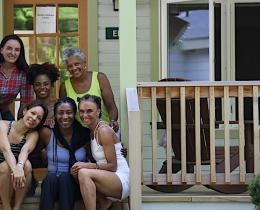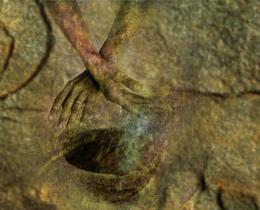Love of self, love of other: two strands in the love braid. I have braided these strands together in all sorts of relationships, in varying degrees of grace and ineptitude. I’ve messed up in both directions: being self-centered, being a martyr; not knowing my own worth, not valuing the essential worth of the other. To love well is to get the balance right. It’s the work of a lifetime.
When my sister’s cancer recurred after seven years of remission; when we were told her only chance for survival was a bone marrow transplant; when test results confirmed I was a perfect marrow match; when we prepared ourselves, body and soul, to give and receive; when my marrow was harvested; when she received my stem cells that would become her blood cells; when we traveled together through the thickets of despair and hope; when she lived what she said was the best year of her life; when the cancer returned; when she faced the end; when she died; when all of this happened, I took up the strands of myself and braided them together with my sister’s strands, and I finally got it right. Although “getting it right” sounds more tidy and final than love ever is. There is no ten-ways-to-get-it-right list when it comes to love. No exact formulas for when to be vulnerable and when to be strong, when to wait and when to pursue, when to relent and when to be a relentless love warrior. Rather, love is a mess, love is a dance, love is a miracle. Love is also stronger than death, but I’m only learning that now.
Loving your fate is the way to wisdom and the key to love.
I must add here that there was another strand that my incredibly brave sister added to complete the love braid and, in doing so, inspired me to do the same. It is the secret strand, the one the philosopher Friedrich Nietzsche called “amor fati”—love of fate. Nietzsche described amor fati as the ability not to merely bear our fate but to love it. That’s a tall order. To be human is to have the kind of fate that doles out all sorts of wondrous and horrible things. No one gets through life without big doses of confusion and angst, pain and loss. What’s to love about that? And yet if you say yes to amor fati, if you practice loving the fullness of your fate, if you pick up the third strand of the love braid, you will thread ribbons of faith and gratitude and meaning through your life. Some will reject the idea of loving your fate as capitulation or naïveté; I say it’s the way to wisdom and the key to love.
When I won the cosmic lottery and tested as a perfect match for my sister’s bone marrow transplant, I did what I often do when I’m scared: I became an amateur researcher. I do not like to bury my head in the sand. Rather, I like to arm myself with knowledge, even if in the end the knowledge can become its own form of sand in which I bury myself. But in this case, the research I did into bone marrow, stem cells, and the miracle of transplant went way beyond the acquisition of knowledge. And what my sister and I experienced was much more than a medical procedure.
My research revealed to me that bone marrow transplants are fraught with danger for the recipient. For months after the procedure my sister would face two life-threatening situations. First, her body might reject the stem cells that would be extracted from my bone marrow and transplanted into her bloodstream. And, second, my stem cells, once in my sister’s body, might attack their new host. Rejection and attack. Both could kill her. The medical professionals were doing everything they could to ensure neither would happen. What if Maggie and I could help them? What if we left the clear sailing of the bone marrow transplant up to the doctors, and conducted a different kind of transplant? What if we met in the marrow of our souls and moved beyond our lifelong tendency to reject and attack each other?
People have said I was brave to undergo the bone marrow extraction. But I don’t really think so—you’d have to be a miserable, crappy person to refuse the opportunity to save your sibling. But getting emotionally naked with my sister...this felt risky. To dig deep into never-expressed grievances, secret shame, behind-the-back stories, blame, and judgment wasn’t something we had done before. But my sister’s life hung in the balance. And so, over the course of a year, sometimes with the help of a guide but mostly on walks and over coffee, just the two of us, and sometimes with our other sisters, we opened our hearts, we left the past behind, and we walked together into a field of love.
What I learned from both transplants—the bone marrow transplant and the soul marrow transplant—is that the marrow of the bones and the marrow of the self are quite similar. Deep in the center of the bones are stem cells that can keep another person alive, perhaps not forever, but for a time and, in the case of my sister, for what she called the best year of her life. Deep in the center of the self are the soul cells of who you really are. Dig for them, believe in them, and offer them to another person, and you can heal each other’s hearts and keep love alive forever.
Here’s one more thing I learned. You don’t have to wait for a life-and-death situation to offer the marrow of yourself to another person. We can all do it, we can do it now, and there’s a chance that the life of our human family does indeed depend on it.



